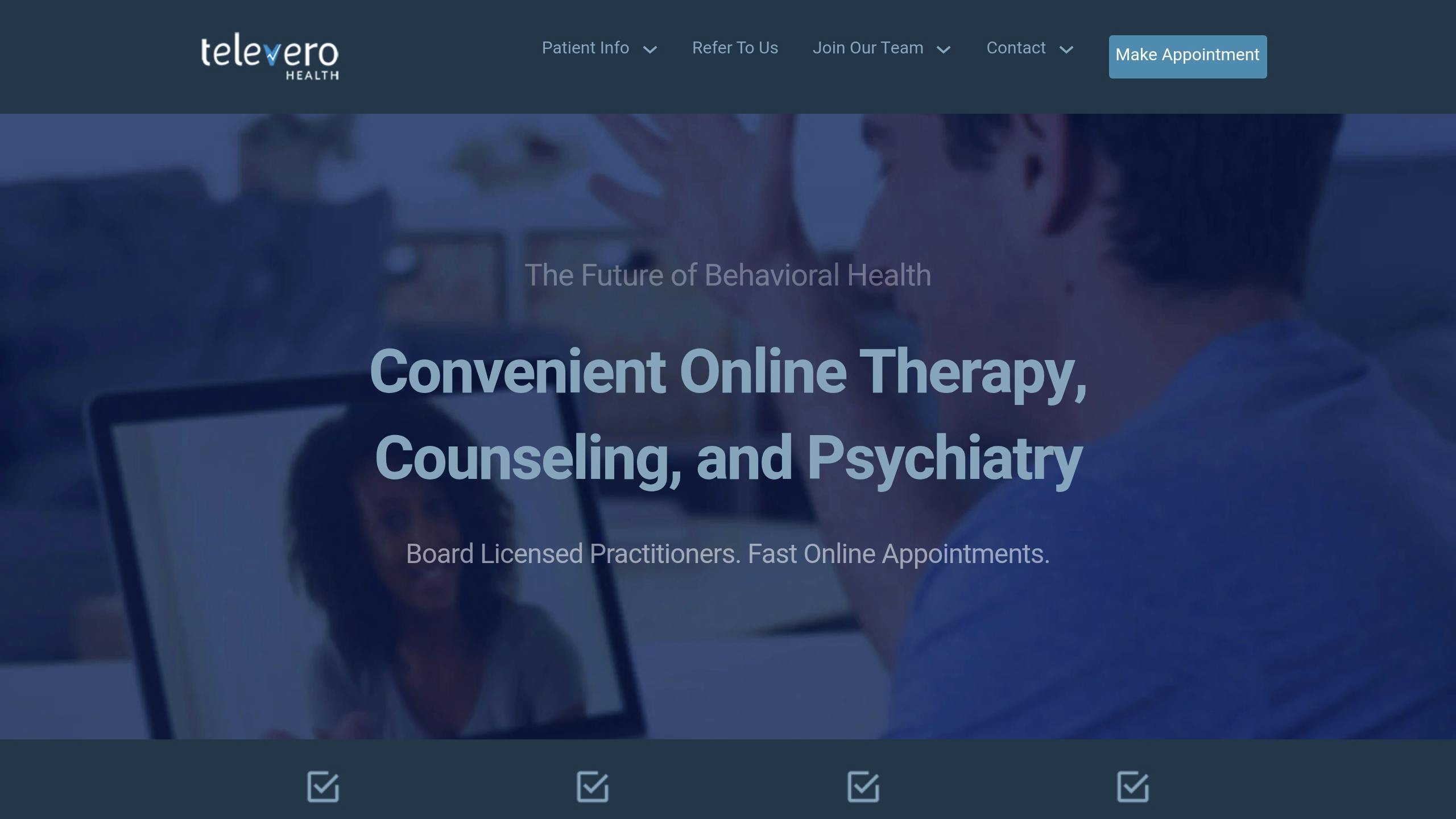Therapy can feel intimidating, especially when it comes to sharing personal thoughts and feelings. Fear of judgment, anxiety, past trauma, or even the “spotlight effect” (feeling overly observed) are common hurdles. Online therapy adds unique challenges, like reduced nonverbal communication, but also offers opportunities for convenience and comfort.
Quick Tips to Start Sharing:
- Start Small: Begin with simple, everyday topics.
- Prepare Ahead: Write down your thoughts before sessions.
- Use Stories: Share your experiences through storytelling to express emotions more naturally.
Why It Matters:
Opening up builds trust with your therapist, strengthens the therapeutic bond, and leads to better outcomes. Research shows that honesty in therapy drives meaningful progress and helps you face life’s challenges with greater resilience.
Ready to take the first step? Start small, prepare, and explore online therapy platforms like Televero Health to make therapy accessible and effective.
How to Prepare for Your First Therapy Session
Why Being Open Matters in Therapy
Understanding how openness changes the therapy experience is key, especially when considering the challenges of online communication. Being honest in therapy isn’t just about sharing – it’s a driver of progress and meaningful change. Research even suggests that people often overestimate the risks of honesty and underestimate how much it helps.
Building Trust Through Sharing
Sharing openly strengthens the connection between client and therapist. Studies show that when clients delve into their inner thoughts and feelings with their therapist, it helps establish a strong bond early on.
This is especially true in virtual therapy settings. Nicolas G. Meade, PhD, Director of Yale New Haven Pediatric Gender Program and Professor of Psychology, notes:
“There is more open dialogue in these groups than when we had in-person groups. Moving forward this is such an excellent solution for our patients.”
Different ways of sharing – like discussing personal stories, current challenges, or past experiences – help uncover patterns, provide immediate support, and create emotional connections.
Better Results Through Honest Communication
Honesty is a game-changer when it comes to therapy outcomes. When clients communicate openly, therapists can offer more precise and helpful guidance. Research also shows that being open boosts a client’s ability to face tough life challenges. Emotional and cognitive engagement during therapy sessions leads to better results.
Interestingly, over 90% of therapists use some level of self-disclosure to create a balanced and trusting relationship. Clients who are open in therapy often experience stronger connections with their therapists and more noticeable progress. This transparency allows therapists to adjust their methods based on real feedback, creating a deeper and more effective therapy process.
Steps to Feel More Comfortable Sharing
Opening up in therapy can feel daunting, but a little preparation can make it easier. These techniques can help you build trust and reduce anxiety while gradually working toward meaningful conversations.
Begin with Simple Topics
Start small. Discussing everyday activities, current events, or general life experiences can help you ease into therapy. This approach builds trust and helps you get comfortable with the process. Over time, as you feel more at ease, you can transition to more personal or challenging topics.
Write Down Your Thoughts First
Once you’ve started with lighter conversations, writing things down can help you feel more prepared and confident. Jotting down your thoughts before a session can help you organize ideas and reduce pre-session nerves. The Therapy Journal highlights this approach:
“‘Topics for This Session’ allows you to set a meeting agenda of sorts, so that you go in with intention, and cover what you feel is a priority.”
Writing offers several benefits:
- Helps you focus on key points during the session
- Creates a record of your progress
- Prevents you from forgetting important topics
For those who struggle with short-term memory, keeping daily notes can be especially helpful in remembering what to bring up during therapy. Plus, expressive writing – writing about your emotions – has been shown to reduce anxiety and depressive symptoms while supporting therapeutic growth.
Use Stories to Express Feelings
Once you’ve written your thoughts, storytelling can help you dive deeper into emotional expression. Dr. Dan Bates explains:
“Listening to a client’s story is incredibly important… Slowing down and listening to the client’s story is the key to exploring their intricacies.”
When sharing a story:
- Add sensory details to make it more vivid
- Start with a neutral or less emotionally charged point
- Focus on specific events rather than generalizations
- Use metaphors if direct expression feels too difficult
Stories are powerful because they bypass overthinking and allow for a more natural, imaginative connection. As Mark Tyrrell notes:
“Stories bypass the shredding effects of over-analysis and conscious reasoning. Stories are inherently hypnotic in that they fixate attention and appeal to the imagination.”
This method not only makes it easier to share difficult emotions but also fosters a deeper and more engaging dialogue with your therapist.
sbb-itb-e6bfb1d
Digital Tools for Online Therapy Success
Technology has reshaped therapy by introducing tools that help track emotions and improve communication. These tools make it easier to share feelings and provide structured ways to monitor emotional well-being.
Mood Tracking Apps
Mood tracking apps are invaluable for observing emotional patterns and preparing for therapy sessions.
- Log your daily mood
- Track activities that influence your emotions
- Add personal notes and reflections
- Secure your entries with PINs, fingerprints, or Face ID
- Export data to share with your therapist
“Never before have I kept track of my emotions this thoroughly. It has helped me to reflect more and stay in touch with what is going on with me.”
Private Messaging Options
Secure messaging platforms extend therapy beyond scheduled sessions, offering continuous support.
- Clients write about 788 words weekly
- Therapists reply with approximately 627 words per week
“If anybody asked me about would definitely tell them to go use it, because they can use it any time of the day, any place, anywhere.”
Online Platforms Like Televero Health

Online platforms such as Televero Health combine multiple tools to create seamless virtual therapy experiences. Televero Health stands out for making therapy more approachable, especially for younger clients. Key statistics highlight its impact:
- 89% of clinicians report better client engagement
- 86% say sessions are more tailored to individual needs
- Clinician satisfaction ranks in the 99th percentile
“Televero Health has transformed my counseling practice by providing an engaging virtual platform for children and teens. It allows me to connect with clients in a way that feels comfortable and accessible for them, making therapy more effective and interactive.”
Televero Health offers:
- HIPAA-compliant video sessions
- Self-assessment tools
- Same-week appointment availability
- A detailed patient portal
- Services for individuals aged 5 to 95
This blend of secure and user-friendly features helps reduce anxiety and fosters the trust needed for effective therapy.
Dealing with Specific Challenges
Participating in virtual therapy comes with its own set of hurdles: building trust, overcoming the fear of being judged, and dealing with feelings of shame. Tackling these challenges is key to fostering meaningful and productive conversations in therapy.
Building Trust Over Time
Establishing trust in a virtual setting takes effort and consistency. Studies suggest that maintaining clear boundaries and a structured approach can positively influence the therapeutic bond. Here are some ways to build trust:
- Stick to consistent session times to create a sense of reliability.
- Position your camera at eye level to encourage better eye contact.
- Choose a quiet, private, and well-lit space to minimize distractions.
- Test your technology beforehand to avoid interruptions.
“Trust is an essential part of an effective patient-provider relationship. A health care relationship with a strong trust foundation improves communication, patient engagement in self-management, and health care outcomes.”
As trust grows, addressing fears of judgment becomes the next step.
Handling Fear of Judgment
The fear of being judged often comes from self-criticism rather than actual external judgment. Here’s how to work through it:
- Practice deep belly breathing to help calm your body and mind.
- Reframe self-criticism into a more compassionate and understanding perspective.
- Redirect focus from negative self-talk to the supportive aspects of your healing journey.
Once fear of judgment is addressed, it becomes easier to confront and process feelings of shame.
Coping with Shame
“Although shame is often avoided, expressing it garners acceptance – if, for example, when you mess up you say ‘I’m sorry, I feel dreadful’ then it is likely you will be forgiven and therefore accepted.”
To effectively work through shame:
- Pay attention to where shame shows up physically in your body, as this awareness can help you process it.
“When we feel ashamed, we are less likely to try to repair the damage, reconnect with the hurt party, or learn from the experience.”
Addressing shame not only strengthens relationships but also deepens your understanding of yourself.
Conclusion: Getting Started
Main Points to Remember
Starting therapy can feel intimidating, but taking it step by step can make the process smoother. Building trust with your therapist is key, and research highlights that the relationship you develop with them – known as the therapeutic alliance – is crucial for achieving your goals.
Here are some tips to help you get started:
- Start small: Begin by sharing general information before diving into deeper topics.
- Prepare ahead: Jot down your thoughts or concerns before each session to stay organized.
- Create a quiet space: Find a private, distraction-free area for your sessions.
- Check your tech: Make sure your device, camera, and internet connection are working properly.
“The most important factor is the therapeutic alliance, or the relationship the client develops with the therapist and their ability to work together to achieve the client’s goals.” – Psychology Today Staff
Once you’re ready, explore online platforms to find a therapist who matches your needs.
Finding Help Online
Virtual therapy platforms make professional care more accessible, and studies suggest that online therapy can be just as effective as in-person sessions. Many platforms offer flexible pricing and features to accommodate different preferences: When choosing a therapist, keep these steps in mind:
- Schedule consultations: Meet with a few therapists to find someone you’re comfortable with.
- Ask about experience: Check if they have worked with issues similar to yours.
- Review payment options: Confirm insurance coverage or self-pay costs.
- Consider cultural preferences: Find a therapist who aligns with your values and background.
Building trust takes time, but it’s worth it. For instance, Calmerry reports that 95% of clients find virtual therapy more convenient than traditional sessions. Start by reaching out to a platform that feels right for you and schedule your first consultation.
